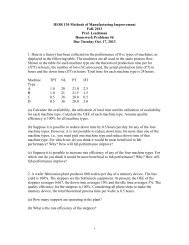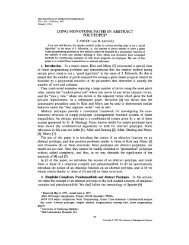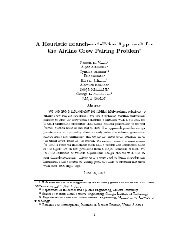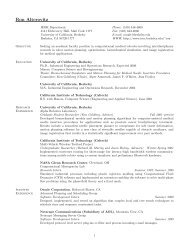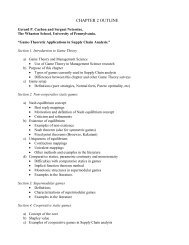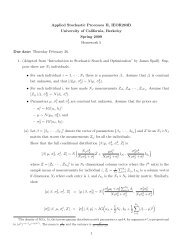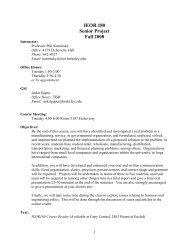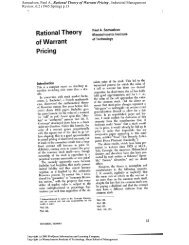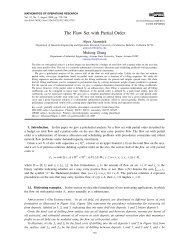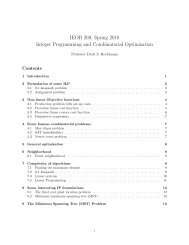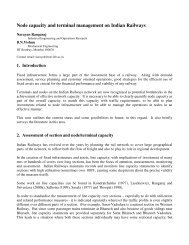A transmission-constrained unit commitment method in ... - CiteSeerX
A transmission-constrained unit commitment method in ... - CiteSeerX
A transmission-constrained unit commitment method in ... - CiteSeerX
Create successful ePaper yourself
Turn your PDF publications into a flip-book with our unique Google optimized e-Paper software.
308<br />
( )<br />
C.-L. Tseng et al.rDecision Support Systems 24 1999 297–310<br />
Table 6<br />
Test result of a large scale problem<br />
Total cost Ž. $<br />
CPU time Ž. s<br />
Dual optimal: 199,216.56 Ph. 1:1292.47<br />
Primal optimal: 200,214.32 Ph. 2:116.60<br />
Duality gap: 1.469% Ph. 3:108.32<br />
Total: 1512.39<br />
contributed by the thermal <strong>unit</strong>s .. The test result is given <strong>in</strong> Table 6. We emphasize that these test results used a<br />
program developed for research purpose with little effort spent <strong>in</strong> speed<strong>in</strong>g up the algorithm performance. The<br />
motivation is to see how the algorithm performs on a large scale problem. We observe: Ž. 1 the convergence of<br />
the dual optimization is not directly affected by the <strong>in</strong>creased number of multipliers correspond<strong>in</strong>g to the<br />
<strong>transmission</strong> constra<strong>in</strong>ts but by the <strong>in</strong>creased number of nonzero multipliers. The more congested the network is,<br />
the more iterations are required to reach a near-optimal dual solution. We observe that the dual objective value<br />
tends to improve more slowly as the congestion of the network <strong>in</strong>creases. Ž. 2 The CPU time required <strong>in</strong> this test<br />
problem, although high, scales approximate l<strong>in</strong>early with problem size. Algorithm performance can be improved<br />
by tak<strong>in</strong>g advantage of the sparsity of the matrix of the distribution factors G and the multipliers associated<br />
with the <strong>transmission</strong> constra<strong>in</strong>ts. Along this direction, a large scale ‘bus-based’ model can be equivalent<br />
reduced to a small sized ‘area-based’ one without violat<strong>in</strong>g problem optimality, and the algorithm performance<br />
can be greatly accelerated w17 x.<br />
5. Conclusions<br />
In this paper we presented a <strong>transmission</strong>-<strong>constra<strong>in</strong>ed</strong> <strong>unit</strong> <strong>commitment</strong> algorithm us<strong>in</strong>g the Lagrangian<br />
relaxation approach. The <strong>transmission</strong> constra<strong>in</strong>ts are formulated as l<strong>in</strong>ear constra<strong>in</strong>ts under the DC power flow<br />
model. The Lagrangian relaxation approach relaxes the demand constra<strong>in</strong>ts, the sp<strong>in</strong>n<strong>in</strong>g reserve constra<strong>in</strong>ts and<br />
the <strong>transmission</strong> constra<strong>in</strong>ts us<strong>in</strong>g multipliers. In this paper, we employ a three-phase algorithmic scheme. Phase<br />
1, the subgradient <strong>method</strong> is used to maximize the dual function to determ<strong>in</strong>e a near-optimal dual solution. A<br />
feasibility phase follows to locate a feasible <strong>commitment</strong>. The feasibility phase is essentially an extension of that<br />
<strong>in</strong> the s<strong>in</strong>gle area <strong>unit</strong> <strong>commitment</strong> case. Initially a reserve-feasible <strong>commitment</strong> is located, then by solv<strong>in</strong>g<br />
l<strong>in</strong>ear programs a dispatchable <strong>commitment</strong> is determ<strong>in</strong>ed. F<strong>in</strong>ally we devise a <strong>transmission</strong>-<strong>constra<strong>in</strong>ed</strong> <strong>unit</strong><br />
de<strong>commitment</strong> <strong>method</strong>, which serves as a post-process<strong>in</strong>g <strong>method</strong> of the algorithm.<br />
In limited numerical tests, the proposed algorithm is found to be efficient and robust. A large scale problem<br />
based on PG&E system is also tested. The result suggests that the proposed algorithm can be used to deal with<br />
practical-sized <strong>transmission</strong>-<strong>constra<strong>in</strong>ed</strong> <strong>unit</strong> <strong>commitment</strong> problems.<br />
Acknowledgements<br />
This work was partly supported by the National Science Foundation under Grant IRI-9120074 and PG&E’s<br />
R&D Department. Their support is greatly appreciated.<br />
References<br />
wx 1 M.S. Bazaraa, C.M. Shetty, Nonl<strong>in</strong>ear Programm<strong>in</strong>g—Theory and Algorithms, Wiley, New York, 1979.<br />
wx 2 D.P. Bertsekas, G.S. Lauer, N.R. Sandell Jr., T.A. Posbergh, Optimal short-term schedul<strong>in</strong>g of large-scale power systems, IEEE<br />
Transactions on Automatic Control AC 28 Ž.Ž 1 1983.<br />
1–11.




